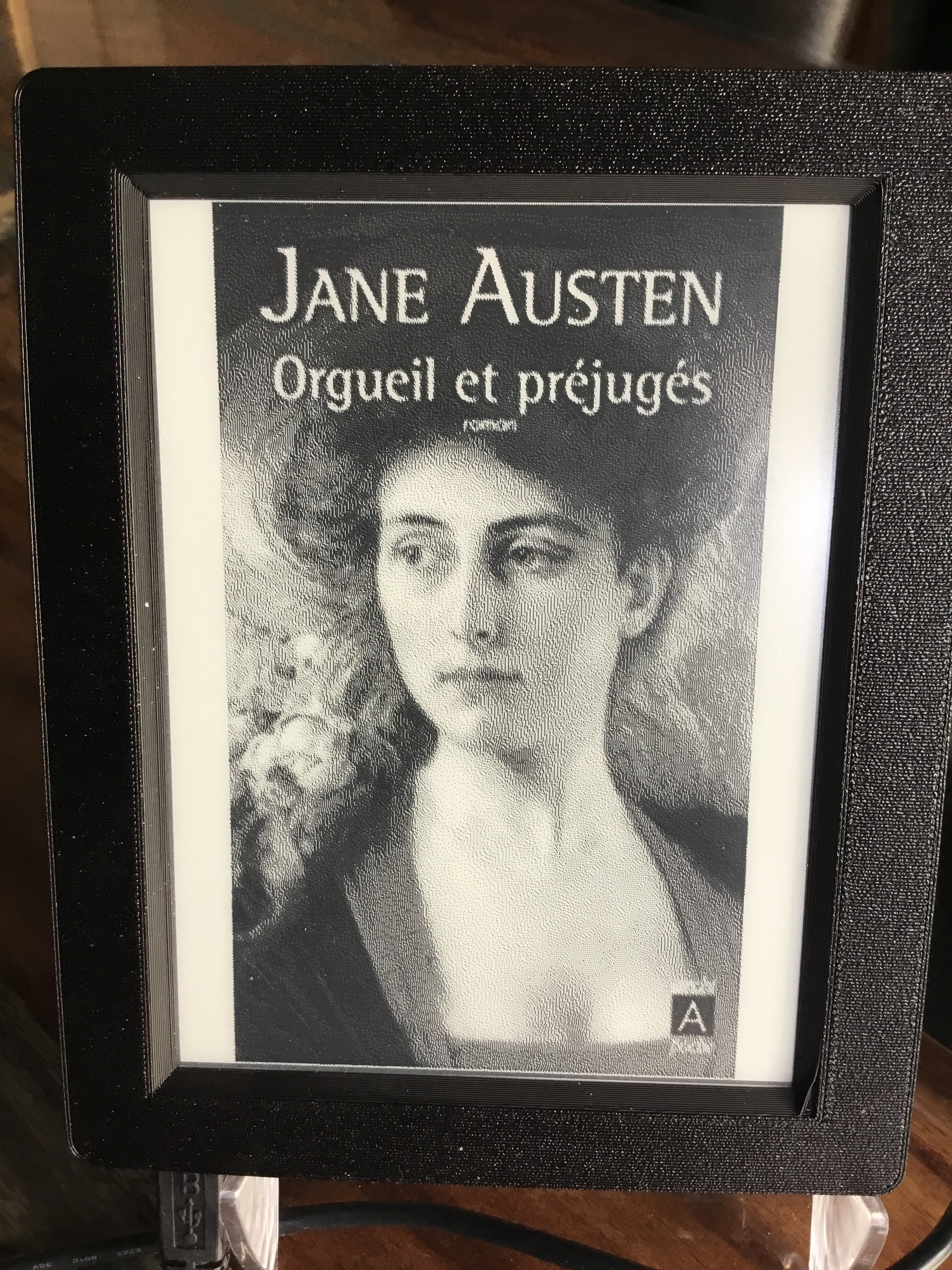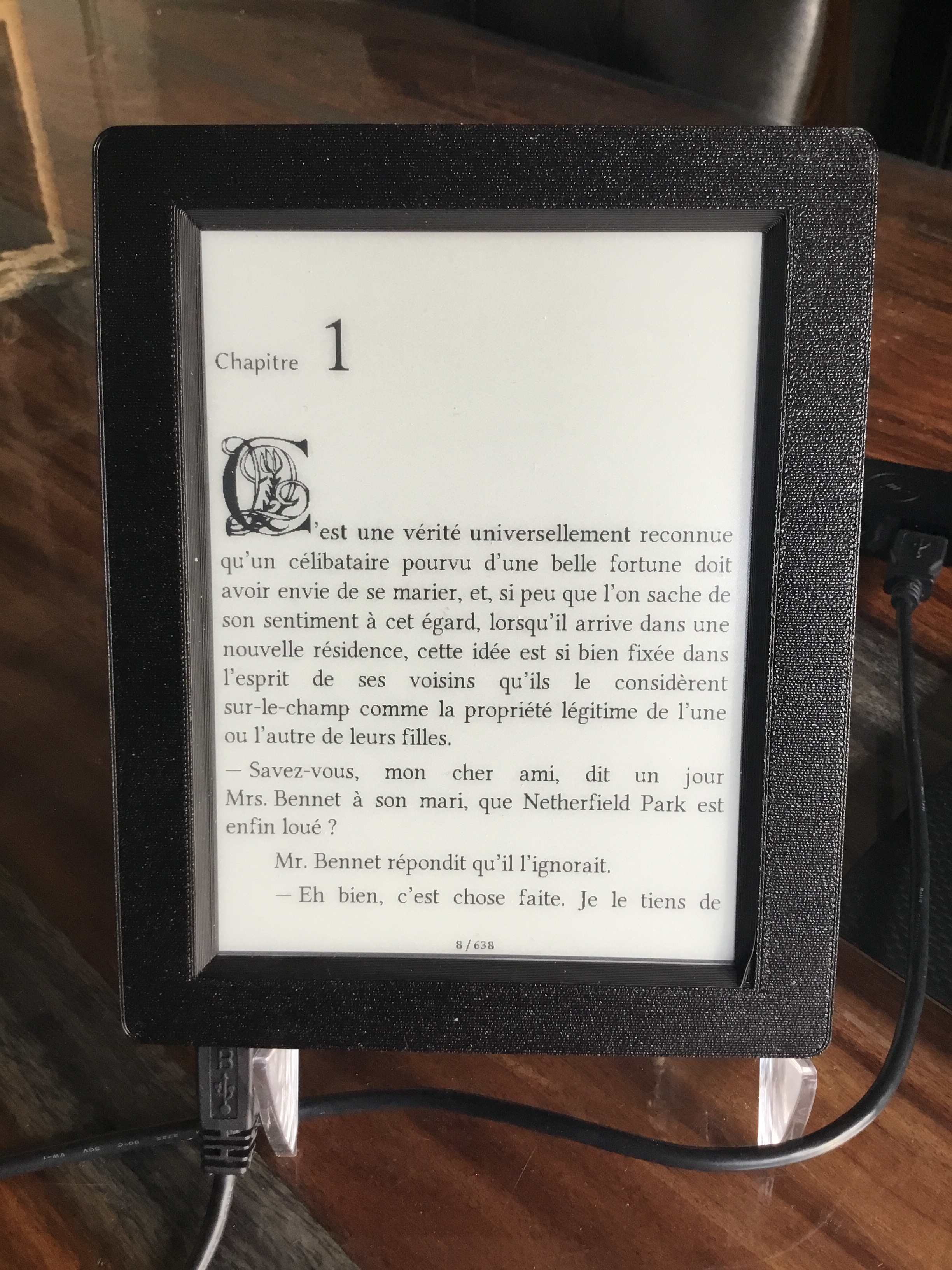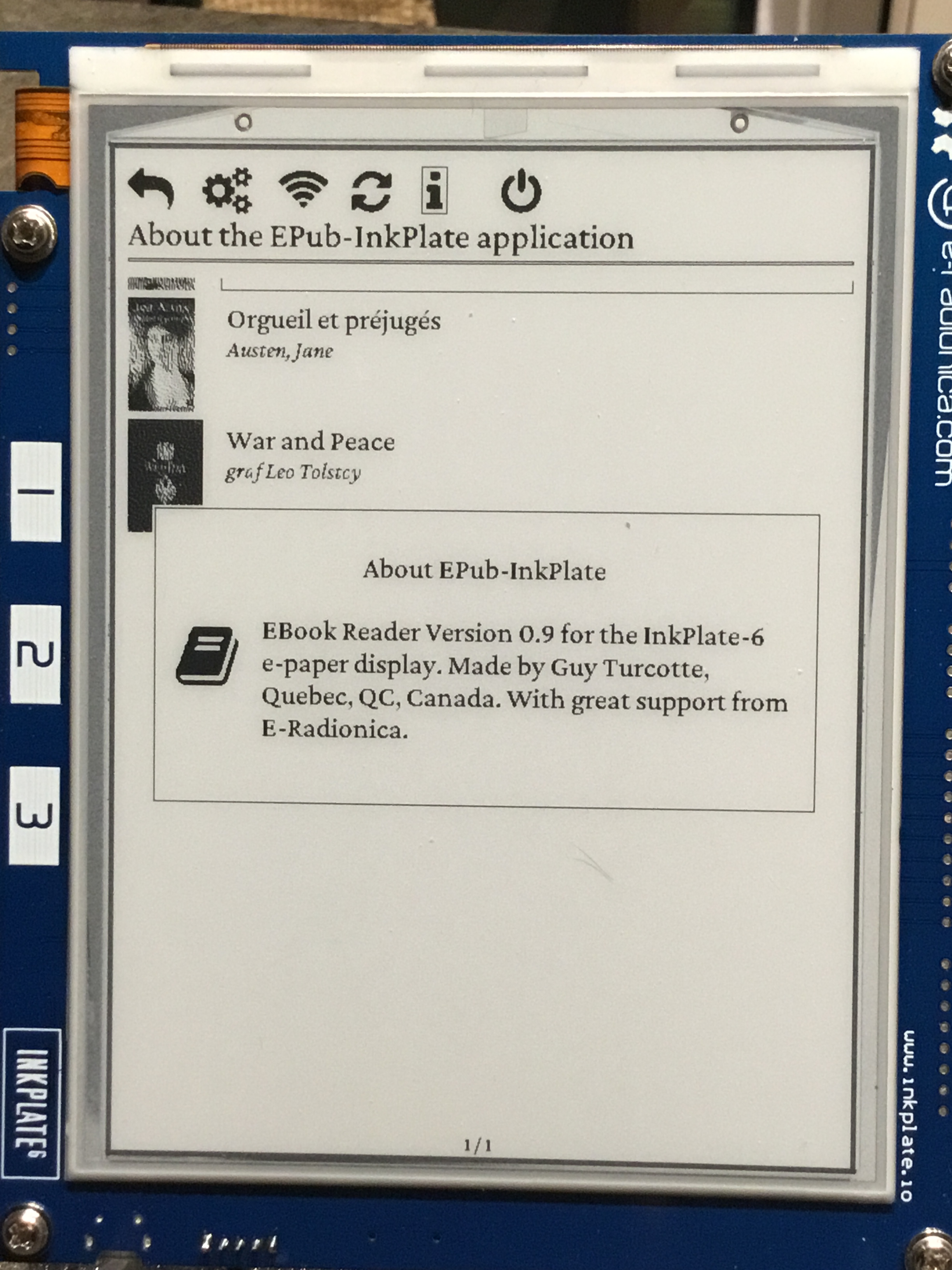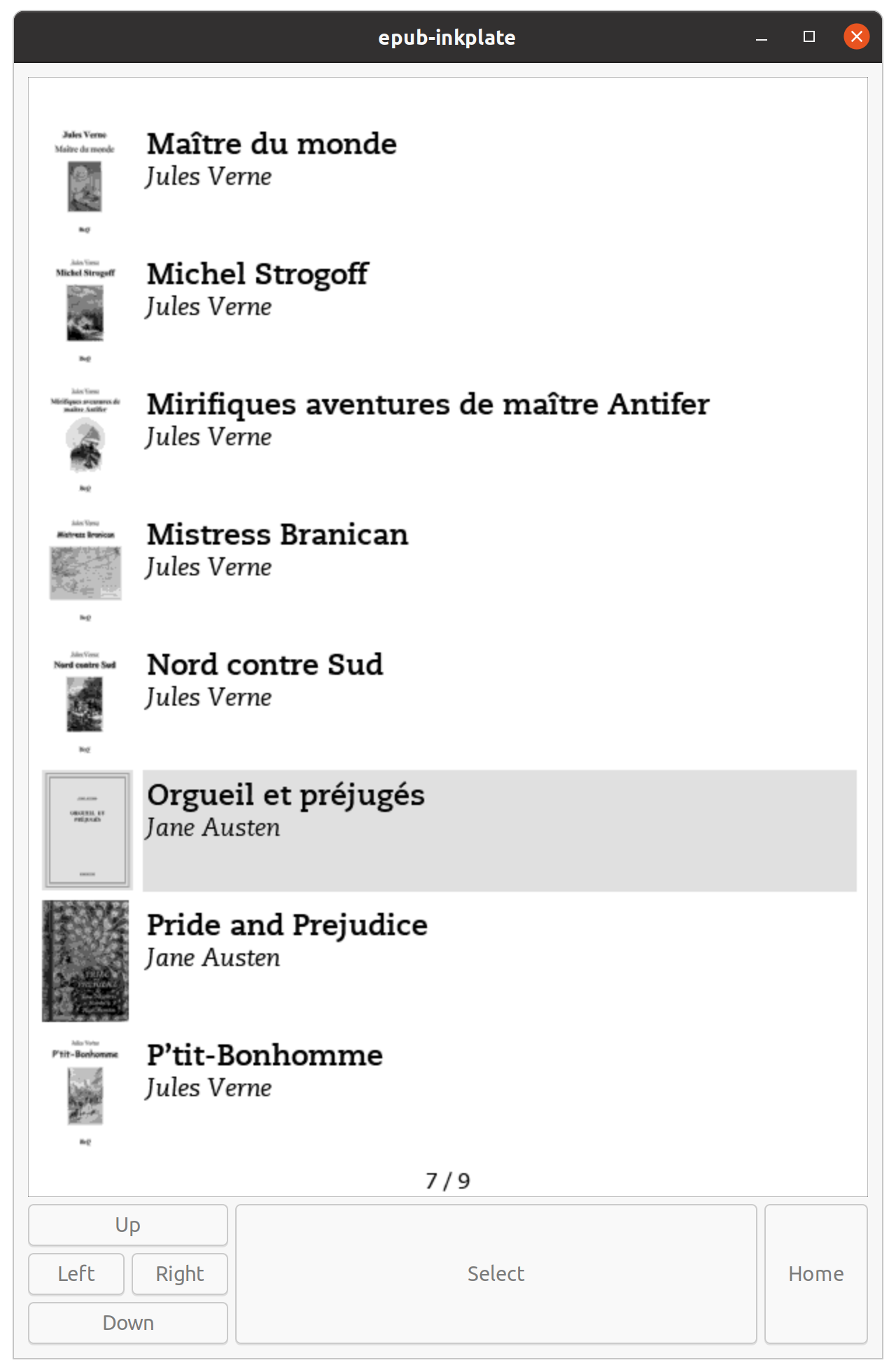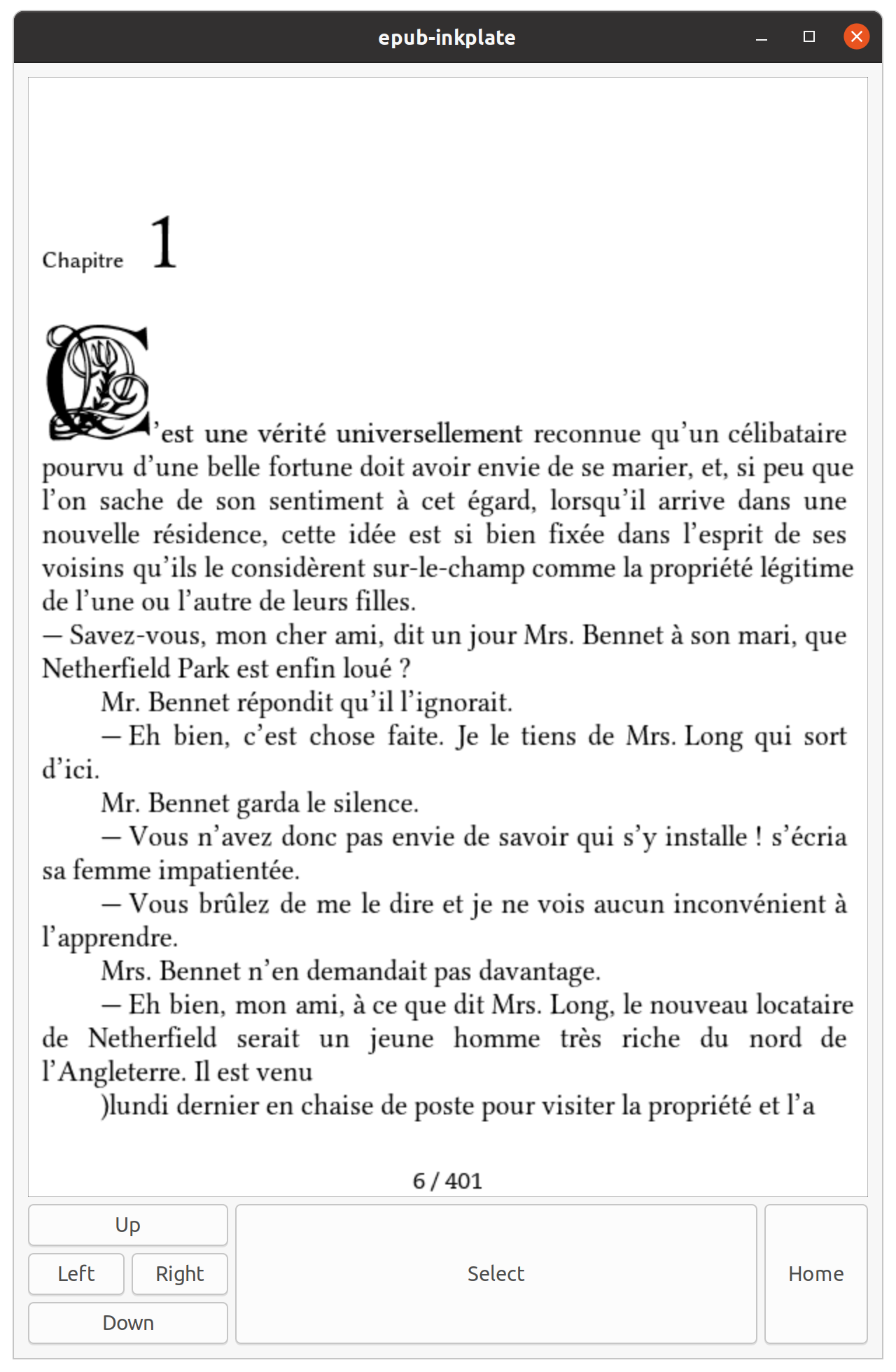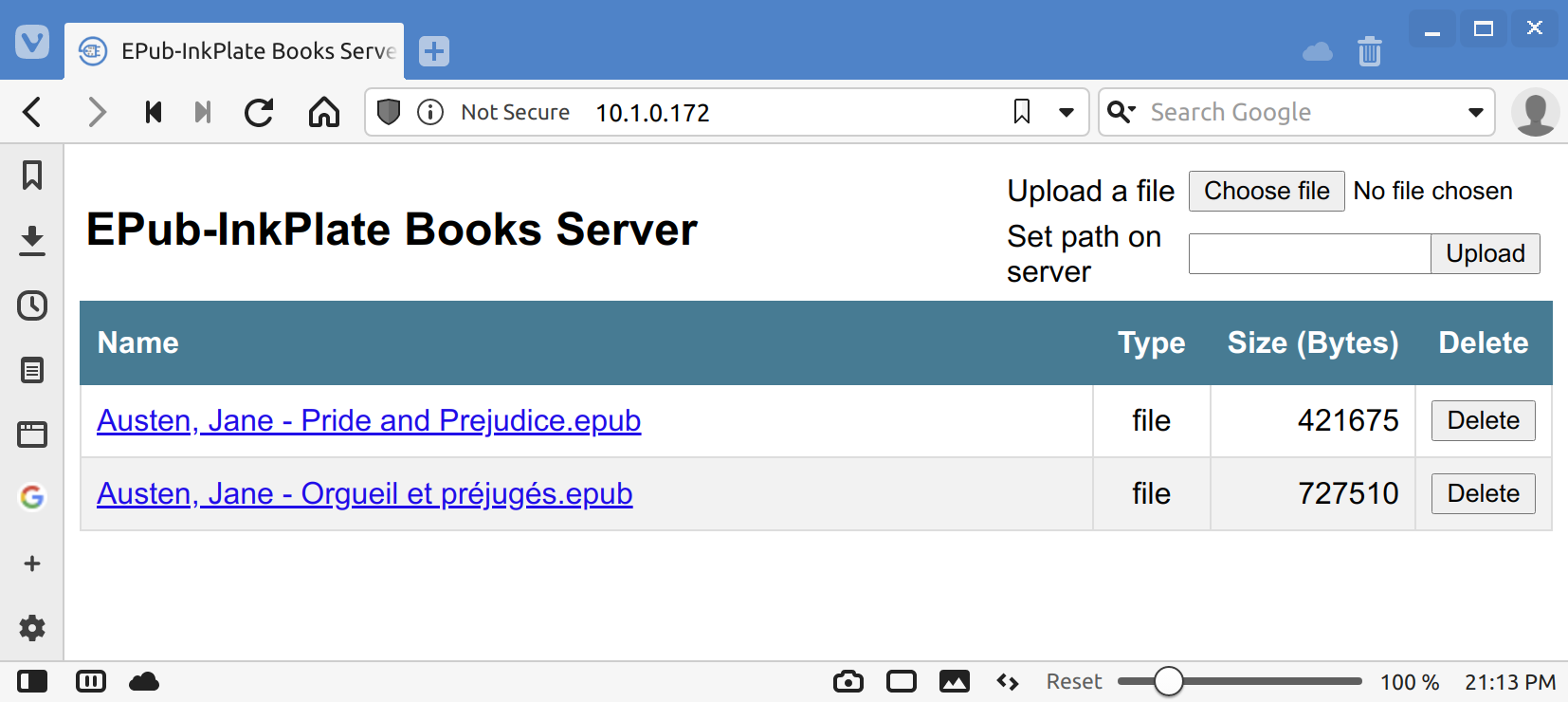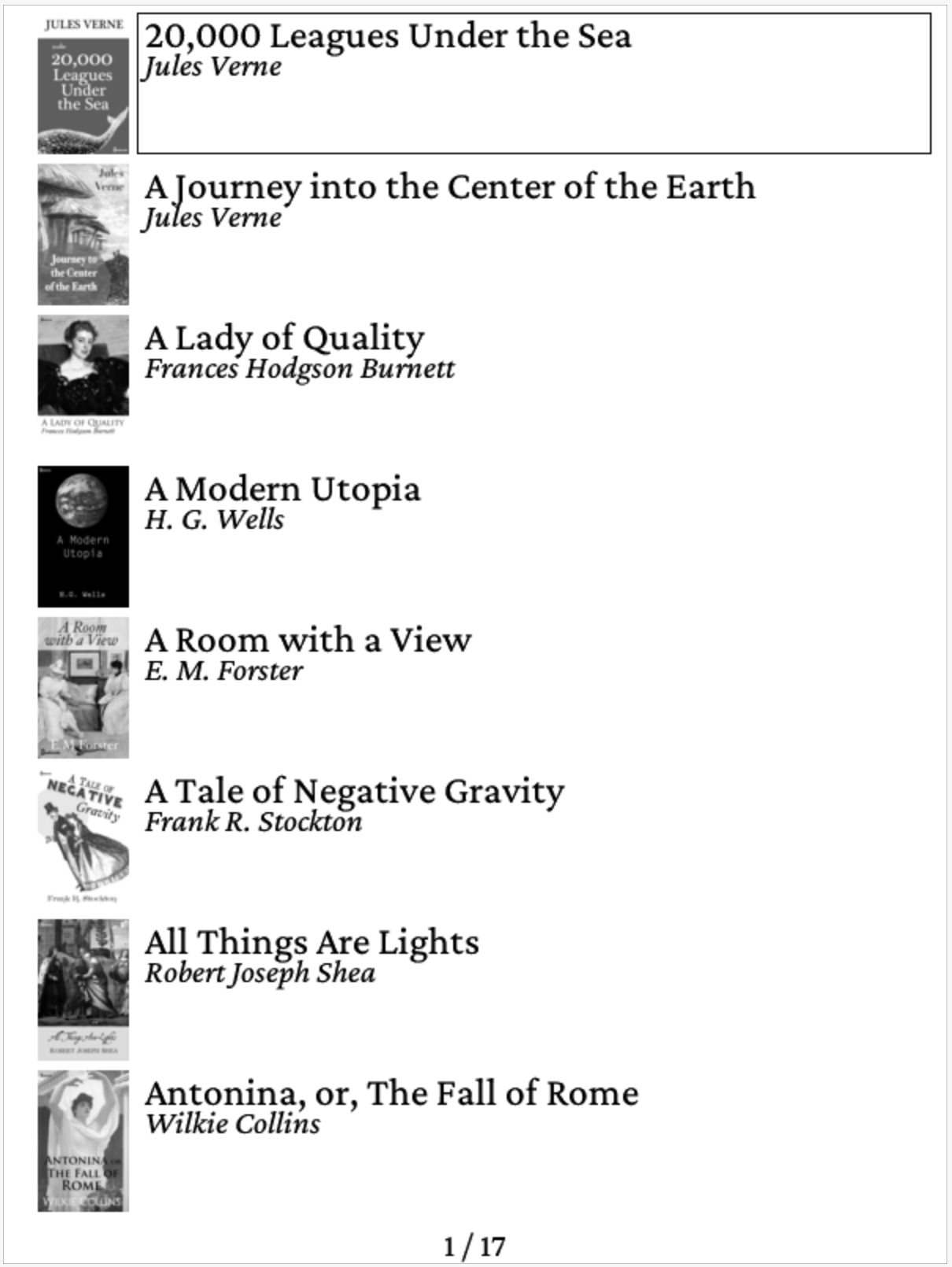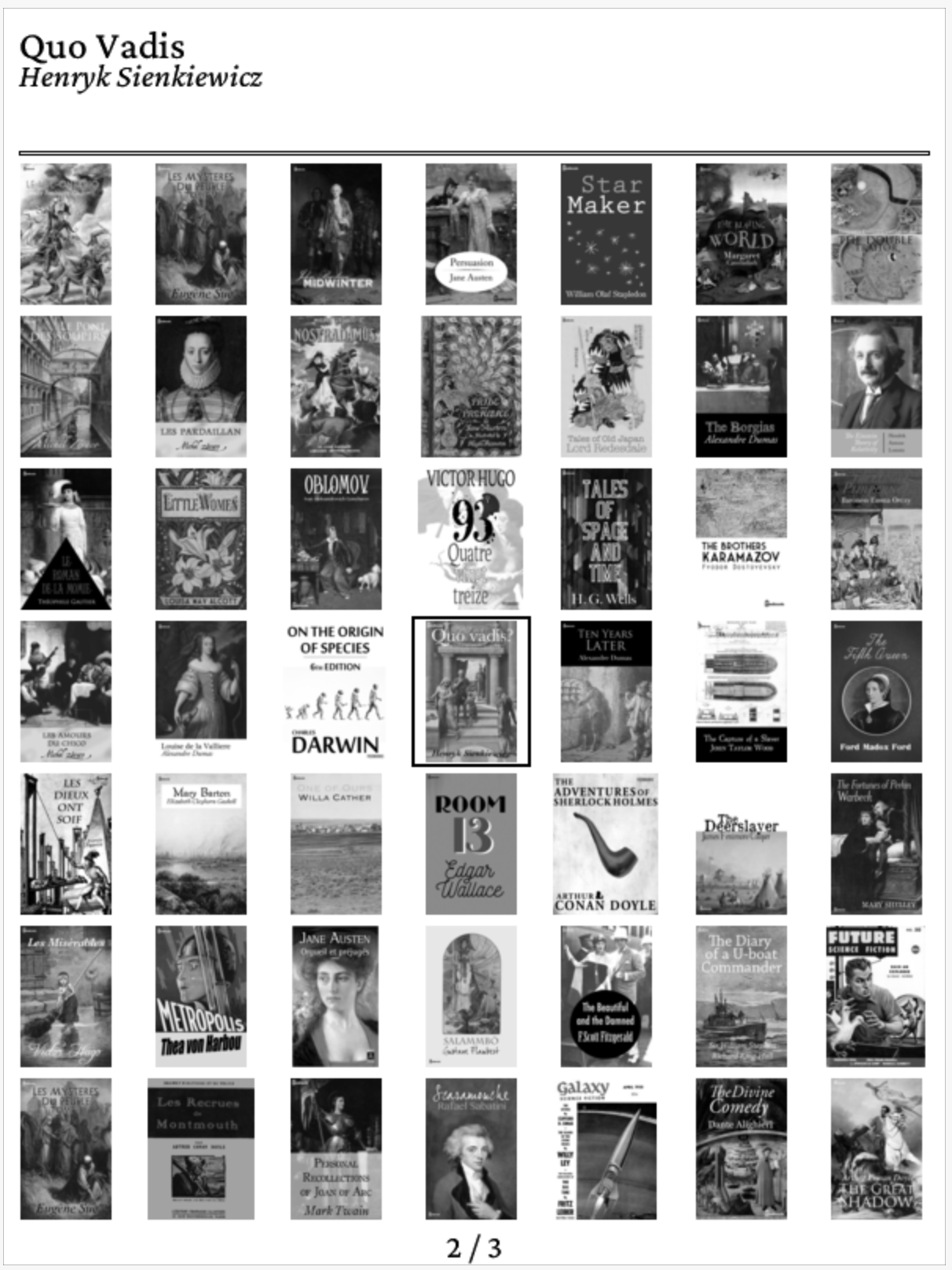(Updated 2022.5.01)
Update to version 2.0.1
-
For Inkplate-6PLUS and Inkplate-10: The ESP-IDF-Inkplate library has been updated (v0.9.6) to support some of these devices to be delivered without a second MCP chip onboard. The presence of the second MCP is now dynamically detected by the software.
-
For all Inkplates: Now using ESP-IDF framework v4.3.2
[ ] A device reset may happen reading a book, and changing the current font as the background process is computing pages location.
This is an EPub reader for the e-Radionica made Inkplate devices.
Here are the main characterics:
- TTF, and OTF embedded fonts support.
- Normal, Bold, Italic, Bold+Italic face types.
- Bitmap images dithering display (JPEG, PNG).
- EPub (V2, V3) book format subset.
- UTF-8 characters (supplied fonts limited to latin1).
- Inkplate tactile keys (single and double click to get six buttons).
- Screen orientation (portrait / landscape).
- Left, center, right, and justify text alignments.
- Font size.
- Indentation.
- Some basic parameters and options.
- Limited CSS formatting.
- WiFi-based documents download (Web server based).
- Battery state and power management (light, deep sleep, battery level display).
- Table of content.
- Multiple fonts choices selectable by the user.
- Linear and matrix view of book list.
- Real-Time clock.
- Inkplate-6PLUS touch screen and backlit.
- Keeps location of the last 10 books being read.
Some vidos are available on YouTube:
- The first working version of the EPub-InkPlate application Here.
- Demostration on the InkPlate-10 Here.
- Demonstration on the Inkplate-6PLUS Here.
Some pictures from the InkPlate-6 version:
Some pictures from the Linux version:
A picture of the Web Server in a browser:
Books Directory List: Linear vs Matrix View:
The EPub-InkPlate application requires that a micro-SD Card be present in the device. This micro-SD Card must be pre-formatted with a FAT32 partition. Two folders must be present in the partition: fonts and books. You must put the base fonts in the fonts folder and your EPub books in the books folder. The books must have the extension .epub in lowercase.
Height font types are supplied with the application. For each type, there are four fonts supplied, to support regular, bold, oblique, and bold-italic glyphs. The application offers the user to select one of those font types as the default font. The fonts have been cleaned-up and contain only Latin-1 glyphs.
Another font is mandatory. It can be found in SDCard/fonts/drawings.otf and must also be located in the micro-SD Card fonts folder. It contains the icons presented in parameters/options menus.
The SDCard folder under GitHub reflects what the micro-SD Card should look like. One file is missing there is the books_dir.db that is managed by the application. It contains the meta-data required to display the list of available ebooks on the card and is automatically maintained by the application. It is refreshed at boot time and when the user requires it to do so through the parameters menu. The refresh process takes some time (between 5 and 10 seconds per ebook) but is required to get fast ebook directory list on screen.
All fonts have been subsetted to Latin-1 plus some usual characters. The fonts/orig folder in the GitHub project contains all original fonts that are processed using the script fonts/subsetter.sh. This script uses the Python pyftsubset tool that is part of the fontTools package. To install the tool, you need to execute the following command:
$ pip install fonttools brotli zopfliThe script takes all font from the orig folder and generate the new subset fonts in subset-latin1/otf folder. The following commands must be executed:
$ cd fonts
$ ./subsetter.shAfter that, all fonts in the subset-latin1/otf folder must be copied back in the SDCard/fonts folder.
Visual Studio Code is the code editor I'm using. The PlatformIO extension is used to manage application configuration for both Linux and the ESP32.
All source code is located in various folders:
- Source code used by both Linux and InkPlate is located in the
includeandsrcfolders - Source code in support of Linux only is located in the
lib_linuxfolder - Source code in support of the InkPlate device (ESP32) only are located in the
lib_esp32folder - The FreeType library for ESP32 is in folder
lib_freetype
The file platformio.ini contains the configuration options required to compile both Linux and InkPlate applications.
Note that source code located in folders old and test is not used. It will be deleted from the project when the application development will be completed.
The following are the libraries currently in use by the application:
-
GTK+3 (Only for the Linux version) The development headers must be installed. This can be done with the following command (on Linux Mint):
$ sudo apt-get install build-essential libgtk-3-dev
The following are imported C header and source files, that implement some algorithms:
-
FreeType (Parse, decode, and rasterize characters from TrueType fonts) A version of the library has been loaded in folder
freetype-2.10.4/and compiled with specific options for the ESP32. See sub-section FreeType library compilation for ESP32 below for further explanations. -
PubiXML (For XML parsing)
-
STB (For image resizing) :
stb_image_resize.hresize images larger/smaller
-
PNGLE (For PNG Images) The EPub-Inkplate uses a modified version that is optimized for grayscale output instead of RGBA.
-
MINIZ (For Zip/PNG files and epub files decompress)
-
TJPGD (For JPeg Images)
The following libraries were used at first but replaced with counterparts:
-
ZLib deflating (unzip). A file deflation function is already supplied with
PNGLE. -
RapidXML (For XML parsing) Too much stack space required. Replaced with PubiXML.
-
SQLite3 (The amalgamation version. For books simple database) Too many issues to get it runs on an ESP32. I built my own simple DB tool (look at
src/simple_db.cppandinclude/simble_db.hpp) -
STB (For image extraction and unzip) Requires a lot of memory space depending on the ePub stored image resolution. Changed to use PNGLE and TJPGD combined with my own image classes to stream the image to the appropriate size without requiring to much memory space:
stb_image.hPNG and JPeg images extraction
The FreeType library is using a complex makefile structure to simplify (!) the compilation process. Here are the steps used to get a library suitable for integration in the EPub-InkPlate ESP32 application. As this process is already done, there is no need to run it again, unless a new version of the library is required or some changes to the modules selection are done.
-
The folder named
lib_freetypeis created to receive the library and its dependencies at install time:$ mkdir lib_freetype
-
The ESP-IDF SDK must be installed in the main user folder. Usually, it is in folder ~/esp. The following location documents the installation procedure: https://docs.espressif.com/projects/esp-idf/en/latest/esp32/get-started/index.html . Look at Steps 1 to 4 (Setting Up Development Environment). This is important as the configuration setup below will access ESP32 related compilation tools.
-
The files
freetype-2.10.4/modules.cfgandfreetype-2.10.4/include/freetype/config/ftoption.hare modified to only keep the capabilities required to support TrueType and OpenType fonts. The original files have been saved in*.origfiles. -
A file named
freetype-2.10.4/myconf.shis created to simplify the configuration of the makefile structure. The--prefixoption may require some modification to take into account the location where the EPub-InkPlate source code has been put. The--prefixmust point to thelib_freetypefolder. -
The following commands are executed:
$ cd freetype-2.10.4 $ bash myconf.sh $ make $ make installThis will have created several files in the folder
lib_freetype. -
Edit file named
lib_freetype/lib/pkgconfig/freetype2.pcand remove the entire line that containsharfbuzzreference. -
Voilà...
The EPub-InkPlate application requires some functionalities to be properly set up within the ESP-IDF. To do so, some parameters located in the sdkconfig file must be set accordingly. This must be done using the menuconfig application that is part of the ESP-IDF.
The following is not required to be done as the file sdkconfig.defaults contains the changes that will trigger the generation of the suitable sdkconfig.<project_name> file related to the project being compiled.
The current release of PlatformIO allow for editing the sdkconfig through the PlatformIO's Run Menuconfig command located in the Project Tasks.
The application will show a list of configuration aspects.
The following elements have been done (No need to do it again as they are defined in file sdkconfig.defaults):
-
PSRAM memory management: The PSRAM is an extension to the ESP32 memory that offers 4MB+4MB of additional RAM. The first 4MB is readily available to integrate into the dynamic memory allocation of the ESP-IDF SDK. To configure PSRAM:
- Select
Component Config>ESP32-Specific>Support for external, SPI-Connected RAM - Select
SPI RAM config>Initialize SPI RAM during startup - Select
Run memory test on SPI RAM Initialization - Select
Enable workaround for bug in SPI RAM cache for Rev 1 ESP32s - Select
SPI RAM access method>Make RAM allocatable using malloc() as well
Leave the other options as they are.
- Select
-
ESP32 processor speed: The processor must be run at 240MHz. The following line in
platformio.inirequest this speed:board_build.f_cpu = 240000000LYou can also select the speed in the sdkconfig file:
- Select
Component config>ESP32-Specific>CPU frequency>240 Mhz
- Select
-
FAT Filesystem Support: The application requires the usage of the micro SD card. This card must be formatted on a computer (Linux or Windows) with a FAT32 partition (maybe not required as this is the default format of brand new cards). The following parameters must be adjusted in
sdkconfig:- Select
Component config>FAT Filesystem support>Max Long filename length>255 - Select
Number of simultaneously open files protected by lock function>5 - Select
Prefer external RAM when allocating FATFS buffer - Depending on the language to be used (My own choice is Latin-1 (CP850)), select the appropriate Code Page for filenames. Select
Component config>FAT Filesystem support>OEM Code Page.... DO NOT use Dynamic as it will add ~480KB to the application!! - Also select
Component config>FAT Filesystem support>API character encoding>... UTF-8 ...
- Select
-
HTTP Server: The application is supplying a Web server (through the use of HTTP) to the user to modify the list of books present on the SDCard. The following parameters must be adjusted:
- Select
Component config>HTTP Server>Max HTTP Request Header Length> 1024 - Select
Component config>HTTP Server>Max HTTP URI Length> 1024
- Select
-
WiFi memory buffers in PSRAM: The WiFi implementation use a large portion of memory. There is not enough main memory available for the buffer required, so it must be allocated from the PSRAM:
- Select
Component config>ESP32-specific>Support for externa,, SPI-connected RAM>SPI RAM config>Try to allocate memories of WiFi and LWIP in SPIRAM firstly.
- Select
The following is not configured through menuconfig:
- Flash memory partitioning: the file
partitions.csvcontains the table of partitions required to support the application in the 4MB flash memory. The factory partition has been set to be ~2.4MB in size (OTA is not possible as the application is too large to accomodate this feature; the OTA related partitions have been commented out...). In theplatformio.inifile, the lineboard_build.partitions=...is directing the use of these partitions configuration.
When I started this effort, I was aiming at supplying a tailored ebook reader for a friend of mine that has been impaired by a spinal cord injury for the last 13 years and a half. Reading books and looking at TV were the only activities she was able to do as she lost control of her body, from the neck down to the feet. After several years of physiotherapy, she was able to do some movement with her arms, without any control of her fingers. She was then able to push on buttons of an ebook reader with a lot of difficulties. I wanted to build a joystick-based interface to help her with any standard ebook reader but none of the commercially available readers allowed for this kind of integration.
On September 27th, 2020, we learned that she was diagnosed with the Covid-19 virus. She passed away during the night of October 1st.
I dedicate this effort to her. Claudette, my wife and I will always remember you!
